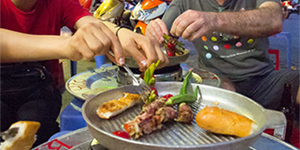Hanoi Streets

Staying longer in the capital city, you will be much clearer about how the locality set the name for streets, markets or places.
In the old times, based on the local square shape, residents opened five gates corresponding to different directions including Chinh Bac (North Gate), Chinh Tay (West gate), Chinh Dong (East Gate), Tay Nam (Southwest gate) and Dong Nam (Southeast gate). Today, their vestiges have partly been remained as small streets within the Old Quarter. Due to that reason, it is understandable that Cua Dong street originated from a big gate dated back from hundreds years before.
With its span of 230m, the street is subdivided into two parts which creates the first link between Ly Nam De Street and the viaduct and the other between the viaduct and Hang Ga Street. Under the French domination, the former part saw several modern buildings mostly catering for officials; meanwhile, the latter was an amazing display of elegant villas with solid protecting gates. Therefore, Cua Dong, among a matrix of streets and guilds in the ancient town, seems more outstanding than others in terms of total coverage and related facilities. You may be rather impressed by nice pavements for pedestrians and a green color covering the street.
To prepare for one trip more thoroughly, the following notes should be kept in your mind whenever you go.
The ancient house at 20 Cua Dong Street is worth-to-visit since it was a crucial base in charge of financial and transporting assistance for Vietnamese revolutionary organizations in the past.
Ngoc Mai Hotel at 7-17 Cua Dong Street is the most commonly chosen by tourists thanks to its nice outlook over Hoan Kiem Lake and a global menu of dishes. You also may feel totally satisfied with domestic and international tours it offers. Hanoi Asia Hotel at 5 is a suitable alternative to relax for leisure travelers.




